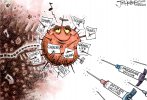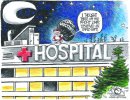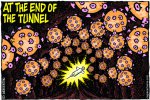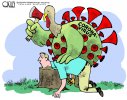Navigation
Install the app
How to install the app on iOS
Follow along with the video below to see how to install our site as a web app on your home screen.
Note: This feature may not be available in some browsers.
More options
Style variation
Guest viewing is limited
- You have a limited number of page views remaining
- 8 guest views remaining
- Register now to remove this limitation
- Already a member? Click here to login
You are using an out of date browser. It may not display this or other websites correctly.
You should upgrade or use an alternative browser.
You should upgrade or use an alternative browser.
Can touching a barbell in the gym get you sick with the coronavirus?
- Thread starter Michael Scally MD
- Start date
A covid-fighting tool is buried in your phone. Turn it on.
https://www.washingtonpost.com/technology/2020/11/18/coronavirus-app-exposure-alerts/
Here’s a phone alert you wouldn’t want to miss: “You have likely been exposed.”
The coronavirus surge is upon us, and your phone might be able to help. About 100 million Americans now have the ability to get pop-up notifications from local health authorities when they’ve personally spent time near someone who later tested positive for the coronavirus.
But exposure notifications only work if you and the people around you turn them on. Yes, you!
There’s early evidence this anonymous smartphone technology works — but so far isn’t helping very many Americans. In August, I wrote about the first of these state-sponsored alerts, Virginia’s Covidwise app. In the three months since, only 488 people have used the state’s app to send alerts about a positive diagnosis to others.
The alerts use software built by Apple and Google into iPhones and Android devices to detect when people (or the phones they’re holding) get into close contact with each other. That might sound like a privacy invasion, but they figured out how to track encounters between people in a way that’s anonymous — and doesn’t store your location — by using the Bluetooth wireless technology in phones.
…
As of Nov. 17, 15 U.S. states and territories, plus D.C., support coronavirus exposure alerts. Here they are, along with links to instructions from the local health department offering them:
Alabama: GuideSafe
Colorado: CO Exposure Notifications
Connecticut: Covid Alert CT
Delaware: Covid Alert DE
Guam: Guam Covid Alert App
Maryland: MD Covid Alert
Michigan: MI Covid Alert
Nevada: Covid Trace
New Jersey: Covid Alert NJ
New York: Covid Alert NY
North Carolina: SlowCovidNC
North Dakota: Care19 Alert
Pennsylvania: Covid Alert PA
Virginia: Covidwise
Washington, D.C.: DC Can
Wyoming: https://covid19.wyo.gov/care19-app
https://www.washingtonpost.com/technology/2020/11/18/coronavirus-app-exposure-alerts/
Here’s a phone alert you wouldn’t want to miss: “You have likely been exposed.”
The coronavirus surge is upon us, and your phone might be able to help. About 100 million Americans now have the ability to get pop-up notifications from local health authorities when they’ve personally spent time near someone who later tested positive for the coronavirus.
But exposure notifications only work if you and the people around you turn them on. Yes, you!
There’s early evidence this anonymous smartphone technology works — but so far isn’t helping very many Americans. In August, I wrote about the first of these state-sponsored alerts, Virginia’s Covidwise app. In the three months since, only 488 people have used the state’s app to send alerts about a positive diagnosis to others.
The alerts use software built by Apple and Google into iPhones and Android devices to detect when people (or the phones they’re holding) get into close contact with each other. That might sound like a privacy invasion, but they figured out how to track encounters between people in a way that’s anonymous — and doesn’t store your location — by using the Bluetooth wireless technology in phones.
…
As of Nov. 17, 15 U.S. states and territories, plus D.C., support coronavirus exposure alerts. Here they are, along with links to instructions from the local health department offering them:
Alabama: GuideSafe
Colorado: CO Exposure Notifications
Connecticut: Covid Alert CT
Delaware: Covid Alert DE
Guam: Guam Covid Alert App
Maryland: MD Covid Alert
Michigan: MI Covid Alert
Nevada: Covid Trace
New Jersey: Covid Alert NJ
New York: Covid Alert NY
North Carolina: SlowCovidNC
North Dakota: Care19 Alert
Pennsylvania: Covid Alert PA
Virginia: Covidwise
Washington, D.C.: DC Can
Wyoming: https://covid19.wyo.gov/care19-app
I work in a State Prison. I work in both Positive and Close Contact units. State prison has over 85% asymptomatic. That means they are positive with no symptoms. Most who get it, no symptoms. The halls are not lined with bodybags, and our small on site healthcare staff are not overburdened. Of 1100 positive at my facility, on 5 are hospitalized offsite currently. All people that go to the hospital, are frequent fliers to the hospital for other health concerns.
98% of inmates watch CNN. Not an actual statistic, but literally all of them. They were scared as hell when it first hit, because of the way the media has spun it. Now, they realize how much it has been blown out of proportion. They will ask "is everyone still freaking out out there?" Then follow up with "if only they knew". Basically, that it's all a political grandstand. It's real, but it's blown up. Originally, the Surgeon General advised against mask, due to constant adjustment and touching of mask, could increase spread. Then he came out some time later retracting his statement.
I have never touched my face this much, until the mask. All inmates wear mask. They all ended up positive. MASK INCREASE SPREAD, because most people don't practice proper mask wearing and hygiene.
A State-by-State Look at Coronavirus in Prisons
The Marshall Project is collecting data on COVID-19 infections in state and federal prisons. See how the virus has affected correctional facilities where you live.
Coronavirus • Updated 4:50 P.M. 11.13.2020
By The Marshall Project
Since March, The Marshall Project has been tracking how many people are being sickened and killed by COVID-19 in prisons and how widely it has spread across the country and within each state. Here, we will regularly update these figures counting the number of people infected and killed nationwide and in each prison system until the crisis abates.
This reporting was undertaken in partnership with The Associated Press.
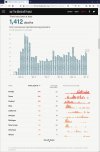
Source: https://www.themarshallproject.org/2020/05/01/a-state-by-state-look-at-coronavirus-in-prisons
For the past 20 years, when patients asked me about exercising while recovering from a viral illness like the flu, I gave them the same advice: Listen to your body. If exercise usually makes you feel better, go for it.
Covid-19 has changed my advice.
Early in the pandemic, as the initial wave of patients with Covid-19 began to recover and clinically improve, my colleagues and I noticed that some of our patients were struggling to return to their previous activity levels. Some cited extreme fatigue and breathing difficulties, while others felt as if they just couldn’t get back to their normal fitness output.
We also began to hear of a higher than normal incidence of cardiac arrhythmias from myocarditis, inflammation of the heart muscle that can weaken the heart and, in rare cases, cause sudden cardiac arrest. Other complications like blood clots were also cropping up.
What was most surprising is that we saw these problems in previously healthy and fit patients who had experienced only mild illness and never required hospitalization for Covid-19.
...
We now know the heart is a particular cause for concern after coronavirus infection. A study in JAMA Cardiology looked at 100 men and women in Germany, average age 49, who had recovered from Covid-19, and found signs of myocarditis in 78 percent. Most had been healthy, with no pre-existing medical conditions, before becoming infected. A smaller study of college athletes who had recovered from Covid-19 found that 15 percent had signs of heart inflammation. Experts continue to assess the data regarding heart risks to help clinicians better determine when athletes can return to play.
MisterSuperGod
New Member
Cancel Thanksgiving, LOL. Okay, Dr. Dingus. Keep holding your breath.
And there we have it. Still using the pandemic as a political weapon. i wonder why so many don't take this shit seriously.
[OA] Love During Lockdown
Introduction: Australia recorded its first case of COVID-19 in late January 2020. On 22P March 2020, amid increasing daily case numbers, the Australian Government implemented lockdown restrictions to help 'flatten the curve'. Our study aimed to understand the impact of lockdown restrictions on sexual and reproductive health. Here we focus on sexual practices.
Methods: An online survey was open from the 23PP April 2020 to 11P May 2020. Participants were recruited online via social media and other networks and were asked to report on their sexual practices in 2019 and during lockdown. Logistic regression was used to calculate the difference (diff) (including 95% CIs) in the proportion of sex practices between time periods.
Results: Of the 1187 who commenced the survey, 965 (81.3%) completed it. Overall, 70% were female and 66.3% were aged 18-29 years. Most (53.5%) reported less sex during lockdown than in 2019.
Compared with 2019, participants were more likely to report sex with a spouse (35.3% vs 41.7%; diff=6.4%; 95% CI 3.6 to 9.2) and less likely to report sex with a girl/boyfriend (45.1% vs 41.8%; diff=-3.3%; 95% CI -7.0 to -0.4) or with casual hook-up (31.4% vs 7.8%; 95% CI -26.9 to -19.8).
Solo sex activities increased; 14.6% (123/840) reported using sex toys more often and 26.0% (218/838) reported masturbating more often.
Dating app use decreased during lockdown compared with 2019 (42.1% vs 27.3%; diff= -14.8%; 95% CI -17.6 to -11.9). Using dating apps for chatting/texting (89.8% vs 94.5%; diff=4.7%; 95% CI 1.0 to 8.5) and for setting up virtual dates (2.6% vs 17.2%; diff=14.6%; 95% CI 10.1 to 19.2) increased during lockdown.
Conclusion: Although significant declines in sexual activity during lockdown were reported, people did not completely stop engaging in sexual activities, highlighting the importance of ensuring availability of normal sexual and reproductive health services during global emergencies.
Coombe J, Kong FYS, Bittleston H, et al. Love during lockdown: findings from an online survey examining the impact of COVID-19 on the sexual health of people living in Australia. Sex Transm Infect. 2020 Nov 17:sextrans-2020-054688. doi: 10.1136/sextrans-2020-054688. Epub ahead of print. PMID: 33203737. Love during lockdown: findings from an online survey examining the impact of COVID-19 on the sexual health of people living in Australia | Sexually Transmitted Infections
Introduction: Australia recorded its first case of COVID-19 in late January 2020. On 22P March 2020, amid increasing daily case numbers, the Australian Government implemented lockdown restrictions to help 'flatten the curve'. Our study aimed to understand the impact of lockdown restrictions on sexual and reproductive health. Here we focus on sexual practices.
Methods: An online survey was open from the 23PP April 2020 to 11P May 2020. Participants were recruited online via social media and other networks and were asked to report on their sexual practices in 2019 and during lockdown. Logistic regression was used to calculate the difference (diff) (including 95% CIs) in the proportion of sex practices between time periods.
Results: Of the 1187 who commenced the survey, 965 (81.3%) completed it. Overall, 70% were female and 66.3% were aged 18-29 years. Most (53.5%) reported less sex during lockdown than in 2019.
Compared with 2019, participants were more likely to report sex with a spouse (35.3% vs 41.7%; diff=6.4%; 95% CI 3.6 to 9.2) and less likely to report sex with a girl/boyfriend (45.1% vs 41.8%; diff=-3.3%; 95% CI -7.0 to -0.4) or with casual hook-up (31.4% vs 7.8%; 95% CI -26.9 to -19.8).
Solo sex activities increased; 14.6% (123/840) reported using sex toys more often and 26.0% (218/838) reported masturbating more often.
Dating app use decreased during lockdown compared with 2019 (42.1% vs 27.3%; diff= -14.8%; 95% CI -17.6 to -11.9). Using dating apps for chatting/texting (89.8% vs 94.5%; diff=4.7%; 95% CI 1.0 to 8.5) and for setting up virtual dates (2.6% vs 17.2%; diff=14.6%; 95% CI 10.1 to 19.2) increased during lockdown.
Conclusion: Although significant declines in sexual activity during lockdown were reported, people did not completely stop engaging in sexual activities, highlighting the importance of ensuring availability of normal sexual and reproductive health services during global emergencies.
Coombe J, Kong FYS, Bittleston H, et al. Love during lockdown: findings from an online survey examining the impact of COVID-19 on the sexual health of people living in Australia. Sex Transm Infect. 2020 Nov 17:sextrans-2020-054688. doi: 10.1136/sextrans-2020-054688. Epub ahead of print. PMID: 33203737. Love during lockdown: findings from an online survey examining the impact of COVID-19 on the sexual health of people living in Australia | Sexually Transmitted Infections
The U.S. health-care system has not reduced the deadliness of the coronavirus since July, according to a new estimate by a prominent COVID-19 researcher, which accounts for the lags in public reporting of cases and deaths. Instead, the virus has, with ruthless regularity, killed at least 1.5 percent of all Americans diagnosed with COVID-19, over the past four months.
This rate is a major improvement, down more than tenfold from the earliest days of the pandemic, when deaths were high and the extreme limits on coronavirus testing held down the number of diagnosed cases. But in this new phase of the pandemic, when testing is more widely available and a much higher proportion of cases are diagnosed to begin with, it is also terrible, terrible news.
Because the case-fatality rate has stayed fixed for so long and there are now so many reported cases, predicting the virus’s death toll in the near term has become a matter of brutal arithmetic: 150,000 cases a day, times 1.5 percent, will lead to 2,250 daily deaths. In the spring, the seven-day average of daily deaths rose to its highest point ever on April 21, when it reached 2,116 deaths. With cases rising as fast as they are, the U.S. could cross the threshold of 2,000 daily deaths within a month. Without a miraculous improvement in care, the United States is about to face the darkest period of the pandemic so far.
The new estimates were prepared by Trevor Bedford, a genomic epidemiologist at the Fred Hutchinson Cancer Research Center, in Seattle, using data from the COVID Tracking Project at The Atlantic, which compiles the cases and deaths that states report. They were then independently analyzed by the forecasting expert Ryan Tibshirani at the Delphi Group at Carnegie Mellon, which works closely with the CDC on disease modeling. If we look back over the past several months, the method Bedford used has proved more accurate than other means of forecasting near-term deaths.
The problem described by these numbers is not abstract. ...
boost creep
Member
The syndrome of Covid-19 infection includes myalgias and elevated creatine kinase levels in at least a third of patients.1-3 Whether the elevation in creatine kinase level is caused by viral infection of muscle, toxic effects of cytokines, or another mechanism is unclear. There are few reports of muscle-biopsy findings in patients with Covid-19.4 We describe a patient with Covid-19 infection and myopathy who had a muscle-biopsy specimen showing evidence of virus-induced type I interferonopathy.
Similar threads
- Replies
- 32
- Views
- 1K
- Replies
- 56
- Views
- 1K
Sponsors
Latest posts
-
-
-
MESO-Rx Exclusive Trenbolone facts - series on unique characteristics of different steroids
- Latest: TheSeptemberKnight
-



